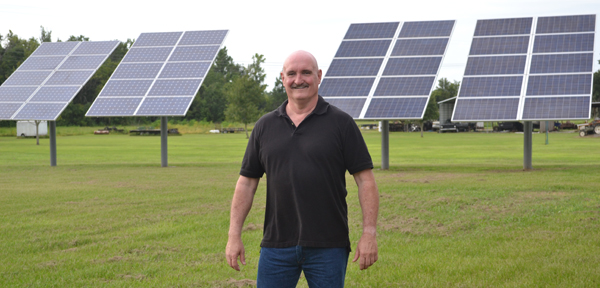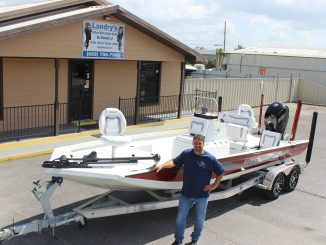
On an overcast day just off Magnolia Ridge Road in Boutte, Ronnie Barger pointed at his digital electric meter that was running backwards.
His electric bill is limited to around $11 per month in fees for the hookup alone while it used to be $180 to $200 a month.
“As you can see, even though it’s not terribly sunny out today I’m producing enough electricity to put back into the system,” he said.
Barger smiles as he turns and gestures toward four large solar arrays filling a space about 40 yards long along the western border of his expansive backyard. He has named them after his four grandchildren – Dew, Nia, JoJo and Buttercup (aka Maricel).
Each array is made up of 10 solar panels mounted together with brackets that altogether measure about 12 feet tall by eight feet wide and sit atop tall posts.
“Each of those posts is 15 feet long, but only about eight feet of it is above ground. The rest of it was driven down and cemented in there,” he said. “Those posts are not going anywhere anytime soon.”
Barger, 58, is close to retirement after working for over 30 years as a police officer in the New Orleans area, but before that he was an electrician’s helper with his father’s construction company. He even worked as an electrician for a few years elsewhere.
“I love that stuff. That it is one of the reasons I got into it like I did,” he said.
Although Barger does not do much electric work anymore, and Lafayette-based Louisiana Solar Solutions installed the panels, he is a solar enthusiast and put a lot of research into the project. However, Barger had another reason for putting up the solar panels.
“Of course they are good for the environment and they help out with pollution, but it wasn’t until I calculated how much my return would be on my investment that I really committed to it,” he said.
Barger said he had some poorly performing deposit investments and when he calculated how much he could save on electricity by investing in solar technology it was an easy decision to make.
“I realized instead of having that money sitting around getting a terrible return I invested in this instead,” he said.
But it would not have been possible if Barger didn’t get state and federal tax credits that paid for 80 percent of the panels’ cost.
So Barger started going about his plan beginning in the December of 2010 when he installed the first array. After spending $15,000 on the first ten panels he ended up getting a rebate of $7,500 from the state and a $4,500 tax write off from the federal government. The tax rebates are limited to $25,000 in purchases per year. Over three years, with each successive instalation, technology improved and the cost went down. Barger was able to purchase enough arrays to provide energy for his entire home with more power to spare. The power he does not use is put back into the Entergy system and he is repaid in credits.
“Right now if I unhooked the panels I could go 7 to 8 months off of the energy I have put back into Entergy’s grid,” he said.
With hurricane season right around the corner, having a large surface area for wind and debris to hit might be a questionable situation, but Barger said he has taken care of that risk as well.
“Damage up to 130 miles per hour is covered by the installers and anything over 130 miles per hour is covered by my insurer,” he said.
The system got a test last year when Hurricane Isaac slashed through the area. Although Barger’s home received about $25,000 worth of damage, the solar panels were not scratched.
In addition to hurricane protection, Barger said the panels are graded for baseball-sized hail traveling at 90 miles per hour and are under a 25-year warranty with an overall expected lifetime of 50 years. That means if they keep producing electricity at their current rate over that entire period of time, Entergy would end up owing him over ten years worth of credits.
Overall Barger said he is happy with how his project has turned out so far.
The biggest issue he has to deal with is when the power goes out. Unlike many other solar powered homes Barger does not have a battery backup and the panels automatically quit transferring electricity into the grid to keep from powering downed lines and endangering workers. He said he thought about getting battery backups, but decided against it after running the numbers and doing further research.
“Right now I can get the 80 percent back in tax incentives if I buy a battery backup system. But when those batteries go bad in five years, and they will, the rebate will not apply to replacements,” he said. “My suggestion is to not get batteries, but to buy a good old fashioned generator because at least your insurer will pay for the cost to run it while the power is out.”
Barger has advice for other homeowners who might follow his lead.
“Look closely at any quote you might receive. There are companies out there who will install the panels and then lease them to you for three years and then try to sell them to you at face value,” he said.
In that scenario the installation company pockets the tax rebates and then pass the full price on to the consumer.
“Always do your research before you go out and do something like this,” he said.




Be the first to comment